By Tom Bultman, Hope College

Many of us enjoy a “cup of Joe” in the morning. For some of us, it’s a prerequisite for productive work. All total, over 2.25 billion cups of coffee are consumed in the world every day, mostly in the U.S., Europe, and Asia.
Many of us enjoy this daily ritual without much thought as to where the beans came from or how they were produced and processed. Given the economic, social, and environmental footprint of this widely traded commodity – it is the second-most valuable export of developing countries – we would do well to take a minute to consider aspects of the supply side of coffee before indulging.
The global average water footprint of eight ounces of coffee is 34 gallons! Most of this is used during washing the beans, which are actually seeds that are removed from cherry fruits produced by the coffee tree.
Coffee farming can also reduce biodiversity; most of the world’s crop is produced on monoculture farms. Further, coffee is also impacted by unsustainable practices that foster global climate change. Yet, issues of unsustainability go far beyond the environmental sector.
Coffee is traded on the global market, including contracts for future purchase. It is thus open to speculators. This and fluctuations in supply and demand result in a highly volatile commodity price. This puts producers and their families at risk. Most coffee is grown by small producers; 12.5 million small land owners worldwide rely on coffee for a living.
The difficulties of producing coffee to support a family are considerable. A labor-intensive endeavor supplies only one annual paycheck. A major challenge is making ends meet during the “thin months” before the next payment from the coffee harvest. The reality is that many coffee producers earn less from coffee than their annual spending needs. Poverty leads to hunger and malnutrition, and malnourished children suffer educational and health deficits that entrench farm families in generational poverty.
Many in the coffee industry are aware of these issues, and some have offered recommendations on how to overcome them. One group, the Specialty Coffee Association, recently published a white paper on the topic, with various ideas.
One avenue of intervention they proposed is to provide farmers with support and assistance to maximize food production potential and attain a balanced diet. This generally takes the form of helping small-scale farmers diversify their farming to grow crops their family can consume. This can include planting fruit trees that provide harvest during the lean months when crops traditionally grown by coffee farmers, like beans and corn, are not in harvest season.
It can also include providing technical improvements in food storage, like silos for grains, to protect a post-harvest crop.

A successful example of this recommendation is Pueblo a Pueblo, an organization that implemented an Organic School Garden Project. Children and parents clear rocks and trees, construct vegetable beds, and erect composting bins. Children plant and maintain the garden. The project not only provides nutritious food, it is also integrated into the curriculum with lessons on biology, chemistry, environmental science, public health, and social studies.
Started at one Guatemalan school in 2011, it has grown to six schools growing more than 38 varieties of vegetables, herbs, flowers and fruit trees. To get involved visit, http://www.puebloapueblo.org/.
A second recommendation of the Specialty Coffee Association white paper is to support livelihood diversification by providing multiple sources of income and food. This often takes the form of training growers in beekeeping and animal husbandry. Honey provides income while livestock enhance diets with needed protein and also provide manure to enrich compost.
An example is the organization Food 4 Farmers. It provides useful information to prospective beekeepers. The bees have the added benefit of improving coffee cherry ripening as well as size and uniformity of the crop. And, beekeeping does not require much land. To get involved visit http://food4farmers.org/our-projects/beekeeping-in-latin-america/.
Another recommendation from the Specialty Coffee Association is to increase industry awareness and action. This can take many forms, but the goal should be to educate and motivate those in the industry to promote sustainability. As consumers, we are part of this equation. An example of such an effort is the
film, “After the Harvest” (http://aftertheharvestorg.blogspot.com/). Viewing it might just change the way you think about coffee.
So, given the situation, what can you do?
Well, you could of course, donate to the organizations listed above and others like them. You could also try to become, if you are not already, an educated consumer. Do you know where the coffee you’re drinking comes from? How it was produced? Some coffee carries with it certifications, like Far Trade, Organic, Bird-Friendly, Rainforest Alliance.
While these are good initiatives, they still do not necessarily allow small-scale farmers to pay for their annual expenses. Many coffee shops and roasters post where their coffee comes from and details about the farms and the farmers that produced the beans. This sort of connection with the source not only gives you information about the quality of the coffee, but can also help inform you of the shop or roaster’s mission concerning sustainability.
Often shops with direct relationships with producers pay far above the commodity price for beans and thus help small-scale farmers make a sustainable living growing coffee. Many shops make sustainability a clear priority and proudly display this.
The next time you visit a shop, ask the barista about the beans and the farm that produced them. If she/he cannot give you an answer, that could tell you something.
Dr. Tom Bultman is a professor of biology at Hope College and teaches invertebrate zoology, biology of insects and general biology I. Bultman also directs the Hope College greenhouse and is an associate editor for the peer reviewed Elsevier journal, Fungal Ecology.
![]() This Week’s Sustainability Framework Theme
This Week’s Sustainability Framework Theme
Environmental Awareness/Action: Environmental education and integrating environmental practices into our planning will change negative outcomes of the past and improve our future.
 ABOUT THIS SERIES
ABOUT THIS SERIES
Living Sustainably is a collection of community voices sharing updates about local sustainability initiatives. It is presented by the Holland-Hope College Sustainability Institute, a joint project of Hope College, the City of Holland and Holland Board of Public Works. Go to www.hope.edu/sustainability-institute for more information.

